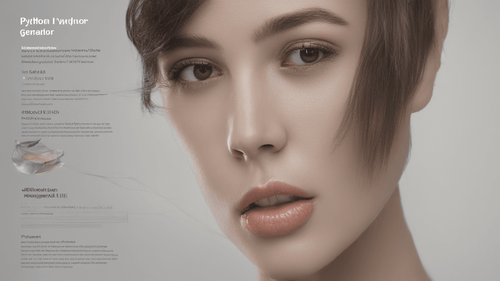
Introduction
In today's rapidly evolving technological landscape, artificial intelligence (AI) continues to revolutionize various industries. One remarkable application of AI is image generation, and Python has emerged as a powerhouse for developing sophisticated AI-driven image generators. In this article, we delve into the captivating realm of Python AI image generators, uncovering their potential, applications, and how they are transforming the creative process.
Python AI Image Generator: Fueling Creative Expression
Python, a versatile and user-friendly programming language, has opened up new horizons in AI-driven image generation. Artists, designers, and developers are leveraging the power of Python to create stunning visuals that push the boundaries of creativity. The fusion of Python's robust libraries with AI algorithms is giving rise to mesmerizing and original artwork that was once beyond imagination.
Understanding AI-Powered Image Generation
How Does Python AI Image Generator Work?
Python AI image generators employ deep learning techniques to analyze patterns, styles, and features present in existing images. These generators consist of neural networks that learn from vast datasets to replicate and even generate entirely new images. By harnessing convolutional neural networks (CNNs) and generative adversarial networks (GANs), Python AI image generators can mimic artistic styles, create imaginative compositions, and even combine elements from different images seamlessly.
What Are the Key Components of Python AI Image Generation?
- Neural Networks: These complex networks of interconnected nodes simulate human neural connections, enabling the AI to recognize intricate patterns and nuances in images.
- Training Data: High-quality and diverse datasets are essential to train the AI model effectively. These datasets encompass a wide range of styles, genres, and subjects.
- Loss Functions: Algorithms utilize loss functions to measure the difference between generated and real images, guiding the AI to refine its output over time.
Applications of Python AI Image Generator
Artistic Creations and Visual Storytelling
Python AI image generators empower artists to explore uncharted territories of creativity. They can seamlessly blend different art forms, generate abstract masterpieces, and even recreate iconic artworks in their unique style. This technology enables artists to convey emotions, concepts, and narratives through visually striking compositions.
Design and Advertising
Designers and advertisers leverage Python AI image generators to craft attention-grabbing visuals for campaigns. From logo design to web banners, these generators offer a wellspring of inspiration and innovation, streamlining the design process and enhancing brand identity.
Gaming and Animation
The gaming industry is embracing Python AI image generators to produce immersive environments, lifelike characters, and captivating animations. By dynamically generating game assets, developers can create expansive virtual worlds that adapt to players' actions and choices.
Fashion and Interior Design
Python AI image generators are revolutionizing fashion and interior design by generating unique textile patterns, clothing designs, and interior layouts. Designers can experiment with countless possibilities, uncovering fresh aesthetics and pushing the boundaries of conventional design.
Challenges and Future Prospects
Overcoming Bias and Stereotypes
One challenge in AI image generation is the potential for bias in the generated content. AI models may inadvertently replicate societal biases present in training data. Addressing this issue requires ongoing research and the development of ethical guidelines to ensure fair and unbiased outputs.
Enhanced Realism and Interactivity
As Python AI image generators continue to evolve, the focus is shifting towards achieving unparalleled realism and interactivity. Advancements in AI algorithms, along with enhanced computing power, are driving the creation of images that are virtually indistinguishable from photographs, opening up new avenues for immersive experiences.
FAQs
What is the Role of Transfer Learning in Python AI Image Generation?
Transfer learning involves utilizing pre-trained neural networks to jumpstart the training process for a new image generation model. This approach enables faster convergence and higher-quality outputs by leveraging the knowledge gained from previously learned tasks.
Can Python AI Image Generators Replace Human Creativity?
Python AI image generators are powerful tools that amplify human creativity rather than replace it. They provide artists and creators with a limitless palette of possibilities, sparking inspiration and facilitating the exploration of novel artistic directions.
How Do Python AI Image Generators Learn Artistic Styles?
Python AI image generators learn artistic styles by analyzing vast datasets of artwork, identifying patterns, brushstrokes, color palettes, and other elements that define a particular style. The AI model then applies these learned features to generate images in a similar style.
What Are the Main Libraries Used in Python AI Image Generation?
Popular Python libraries for AI image generation include TensorFlow, PyTorch, and Keras. These libraries provide a robust foundation for building and training complex neural network models for image creation.
Are Python AI Image Generators Accessible to Beginners?
Yes, Python AI image generators are accessible to beginners. Numerous online resources, tutorials, and courses are available to help individuals with varying levels of programming experience get started with AI image generation using Python.
How Is Python AI Image Generation Transforming the Artistic Landscape?
Python AI image generation is reshaping the artistic landscape by democratizing creativity. It allows artists to experiment with styles, genres, and techniques that were previously challenging to master, enabling them to explore new realms of self-expression.
Conclusion
In the captivating realm of Python AI image generation, the boundaries of creativity are constantly expanding. As technology advances and AI algorithms become more sophisticated, we can expect to witness even more stunning and imaginative artwork brought to life through the harmonious synergy of Python and artificial intelligence. Whether you're an artist seeking inspiration, a designer aiming to innovate, or simply curious about the future of creativity, the Python AI image generator holds the key to unlocking a world of limitless possibilities.